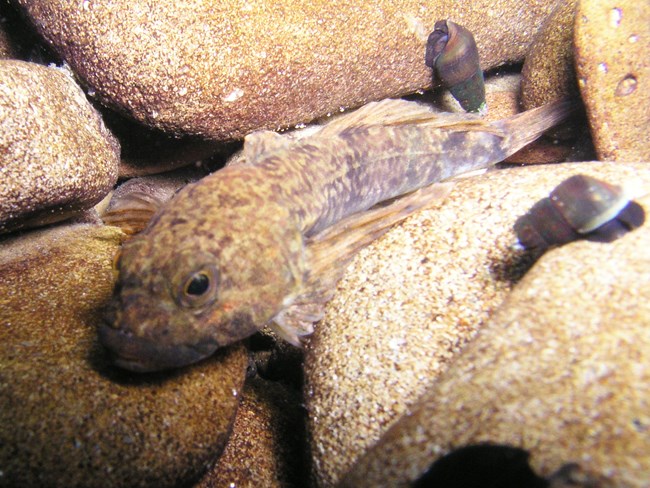Last updated: February 26, 2021
Article
Sculpins

USFWS/Roger Tabor
General Description
Darting low through tide pools or lurking in stream bottoms, members of the large fish family, Cottidae, are commonly called sculpins. They also go by “bullhead” or “sea scorpion,” and even some very unflattering terms, like “double uglies.” You’re not likely to catch one on your fishing line, but if you look carefully into ocean tide pools, you may spot these well camouflaged creatures moving around the bottom. Most of the more than 250–300 known species in this family are marine, though some live in freshwater.
Generally, sculpins are bottom-dwelling small fish, under 13–15 cm (5–6 in) long, with large heads and sizable fanlike pectoral fins. A marine sculpin called the cabezon (Scorpaenichthys marmoratus) is an exception, measuring up to 99 cm (39 in) long! Sculpins often lack body scales, instead sporting modified scales in the form of bony plates, prickles, and spines. The shape and ray sharpness of the lower edge of their pectoral fins can vary by species, presumably based on how tightly they need to grip the substrate. Sculpins look very prickly and their spines can pierce unwary hands! They are well camouflaged, with mottled, muted colors that match the habitat in which they lurk. Some sculpin have moderate ability to change their color to match a new environment. They are very difficult to identify in the hand without a microscope, and as a result, many more species may exist than have been named. One US Forest Service research project, Sculpins of the West, is tackling this challenge by soliciting sculpin DNA samples.
Habitat and Distribution
Sculpins occur in both marine and freshwater habitats of North America, Europe, and Asia, with just a few marine species in the southern hemisphere. Most abundant in the North Pacific, they tend to frequent shallow water and tide pools. In North American coldwater streams, they overlap the same habitat as trout and salmon, including small headwater streams, lakes, and rocky areas of lowland rivers. Freshwater sculpin are sometimes the only abundant fish species in streams. Inland species found in Pacific Northwest streams include the riffle sculpin (Cottus gulosus), prickly sculpin (Cottus asper), and coastrange sculpin (Cottus aleuticus). Pacific staghorn sculpin (Leptocottus armatus) occur in estuaries along the Pacific coast.
Diet and Behavior
Freshwater sculpins typically spend the day hiding under streambed objects and the night feeding on small invertebrates, especially aquatic insect larvae. They eat small crustaceans and worms, as well, and their big mouths can fit an occasional fish. In upstream habitats sculpin may eat salmonid eggs.
Some sculpins, like the tidepool sculpin (Oligocottus maculosus), share an unusual ability with other fish around the world that regularly find themselves in low oxygen conditions. They can breathe air! Low oxygen can occur in tide pools at night when plants have stopped photosynthesizing, or when low tide drains the pool of water. In general, amphibious fish breathe air either through their gills (which are typically larger and thicker than purely aquatic species) or through their skin, which is called cutaneous respiration.

NPS/Dave Hering
Reproduction
Spring is spawning time for many, though not all, freshwater sculpins. After courtship with a territorial male, the female typically sticks around just long enough to lay her eggs in the nest (often a depression under a rock) that the male created, and then she leaves. The male guards and cares for the eggs, fanning them to keep them oxygenated until they hatch a few weeks later into baby fish, known as fry. The fry will be sexually mature in time for the next breeding season.
Fun Facts
- Some sculpins are able to compress their skull bones to fit inside small spaces.
- Despite the unflattering names given to sculpin by some people, at least one beer label sports a sculpin-like image and title!
- Sculpins differ from many other bony fishes because they lack a swim bladder. A swim bladder is a gas-filled sack that a fish can expand or deflate to control its buoyancy in the water column. Lack of a swim bladder fits the sculpin’s bottom-dwelling habits.
Where to See
Freshwater sculpins occur in Whiskeytown NRA, Lassen Volcanic NP, and Redwood NSP. Tide pool and estuary sculpins occur in Redwood NSP. Although sculpins don’t presently occur in Crater Lake NP, a recent stream restoration project for the bull trout (Salvelinus confluentus) led slender sculpin (Cottus tenuis) to expand their range by several kilometers upstream towards the park boundary—an expansion that may eventually reach into the park.
Learn More
https://annebeaudreau.com/2017/09/05/why-i-love-sculpins/
https://www.nwf.org/Magazines/National-Wildlife/1994/Fish-Out-of-Water
Download a pdf of this article.
Prepared by Sonya Daw
NPS Klamath Inventory & Monitoring Network
Southern Oregon University
1250 Siskiyou Blvd
Ashland, OR 97520
Featured Creature Edition: February 2021
Thumbnail image credit: USFWS/Roger Tabor
